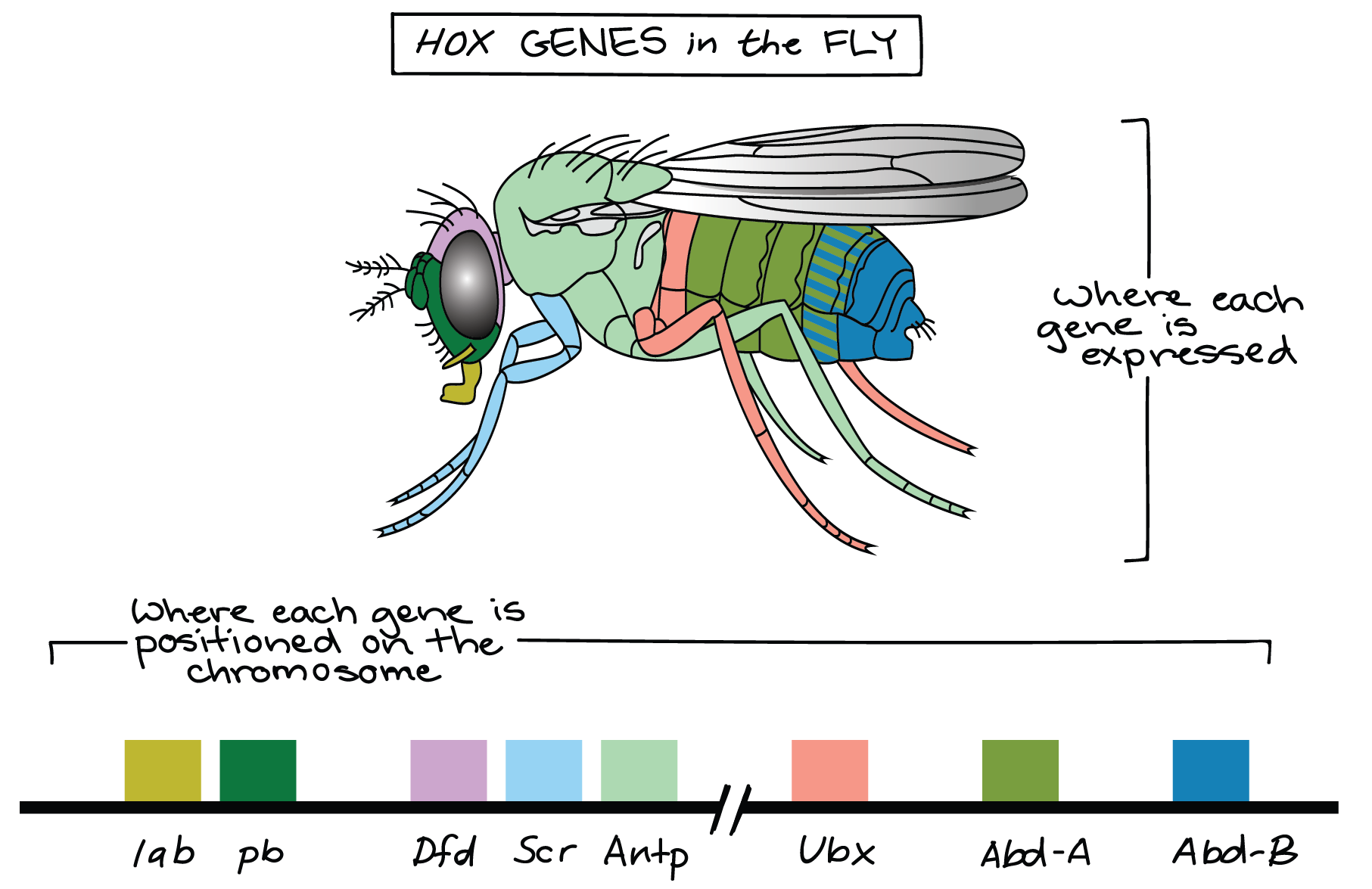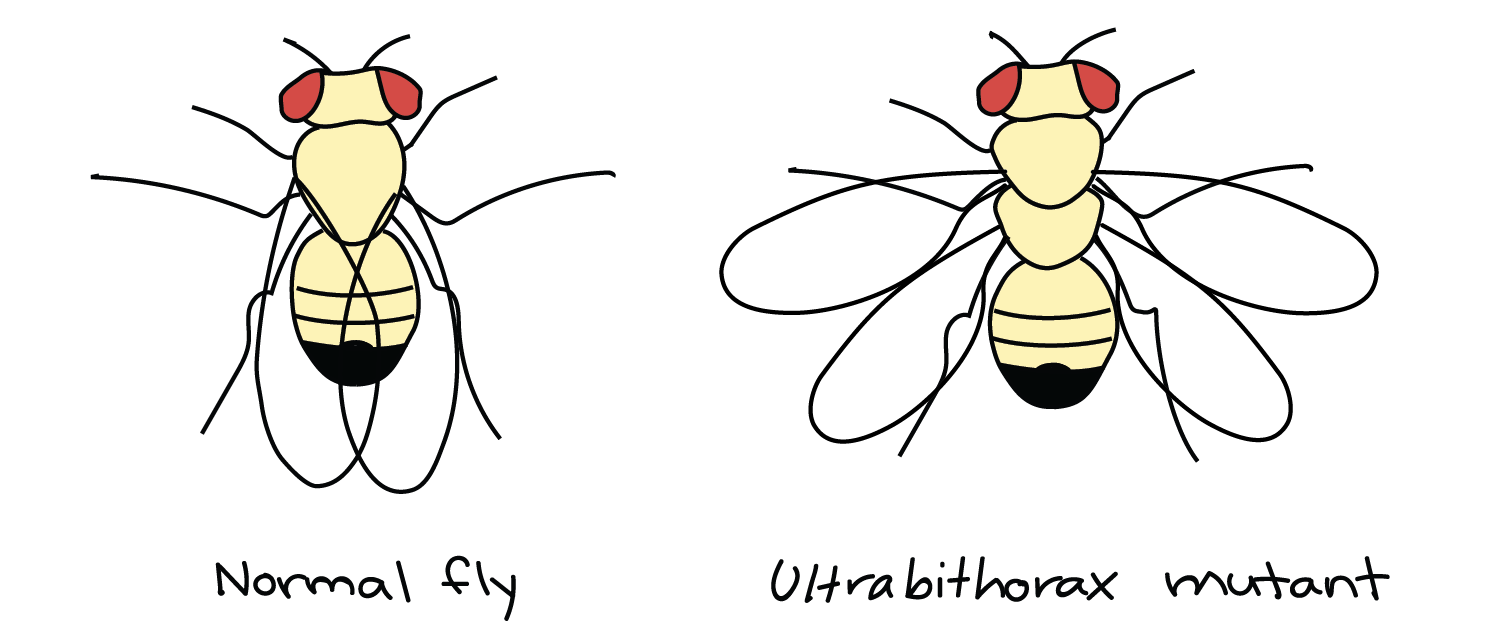A Homeotic Mutation Results in Which of the Following
Mutations in the Hox genes of a fruit fly usually result in abnormal pattern formation. Evolutionary change is more closely associated with changes in gene expression rather than evolution of new proteins I am not sure the premise is true.

Homeotic Genes Article Khan Academy
Which of the following statements about homeotic genes is INCORRECT.

. When homeotic genes are overactivated or inactivated by mutations body structures may develop in the wrong placesometimes dramatically so. Neutral mutation Beneficial mutation Homeotic mutation Synonymous mutation. In Drosophila the misexpression or altered activity of genes from the bithorax complex results in homeotic transformationsOne of these genes abd-A normally specifies the identity of the second through fourth abdominal segments A2 to A4In the dominant Hyperabdominal mutations Hab portions of the third thoracic segment T3 are transformed.
Mutation of homeotic cluster genes often results in which of the followings defects in Drosophila. A homeotic mutation results in the replacement of one body part with another eg replacing antennae with legs in insects. A Ectopic expression of En in a Tubα1en somatic clone in the anterior compartment of the right haltere arrow caused its transformation into a.
A classic example in fruit fly Drosophila species is the switch from halter to wing development in response to mutations in the Ultrabithorax gene Lewis 1963. A loss-of-function mutation in a homeotic gene can result in a switch to the ancestral developmental program. Hox genes code for transcription factors that control the formation of specific structures on particular body segments Wild-type fruit flies exhibit typical pattern formation.
In vertebrates homeotic genes are organized into two distinct. There is a premise there. All homeotic genes contain consensus sequence that result in specific DNA-binding motif.
Mutation in these genes results in absence of a group of segments. A Homeotic mutant fruit fly develops structures on the wrong body segment. The studies of homeotic mutations in Arabidopsis initially.
Another homeotic mutation in flies includes the trait of legs growing out of eyes. Which of the following mutations are most likely to result in large phenotypic effects where whole limbs end up growing in the incorrect location on the body of an organism. Incorrect formation of the body axes b.
Recessive mutations at the plena ple locus result in a homeotic conversion of sex organs to sterile perianth organs in flowers of Antirrhinum majus. Homeotic genes are expressed late in fly development and control segment determination. Replacement of segments with parasegments.
Homeotic change or homeotic transfor-mationthe transfer of a feature typical of one region or segment to another body region or segment. Absorption of UV-A and UV-C. Homeotic genes are the ones that control development of the organism.
Ribosomal protein gene b. This mutation results in an organ appearing in the wrong place. All animals including humans have homeotic genes.
Absorption of UV-A and UV-B. Homeotic transformations in Drosophila. L5Jcs1 is a perinatal lethal mutation uncovered in a screen for ENU-induced mutations on mouse chromosome 5L5Jcs1 homozygotes exhibit posterior-to-anterior transformations of the vertebral column midsection similar to mice deficient for Hoxc8 and Hoxc9Positional cloning efforts identified a mutation in a novel evolutionarily conserved and ubiquitously expressed gene.
A homeotic mutation results in which of the following. Which of the following can cause DNA damage and mutations in humans. A complementary phenotype in which sex organs replace sterile organs is conferred by semidominant.
Incorrect formation of the body axes b. Rna polymerase gene c. The word homeotic has its origins in the Greek word homoios meaning same or similar William Bateson 1894 coined the term homeosis in 1894 to describe a mutation that transforms one structure to the likeness of another particularly with respect to repeated systems such as segments petalssepalsstamens vertebrae etc.
In Drosophila genetics the term is. The general term for any mutation that results in a misplaced organ is homeosis. One of the most evolutionarily conserved homeotic genes is the hox.
Mutation of which of the following would result in the least disruption during development of a frog embryo a. Mutations affecting class A B C and E functions are homeotic resulting in the replacement of one organ type by another. The homeotic mutation that results in double flowers in some rose varieties causes _____ to be converted into _____.
Homeotic genes are genes which regulate the development of anatomical structures in various organisms. Homeotic genes are key players in determining the identity of an organ. Meotic change homeotic mutations and ho-meotic evolution the following definitions will be used.
Homeotic genes are master regulator genes that direct the development of particular body segments or structures. A mutation resulting in a homeotic transformation could either be a gain-of-function or loss-of-function mutation. Biology questions and answers.
Loss of expression of the Arabidopsis C-class gene AGAMOUS AG results in the conversion of reproductive organ fate stamens and carpels to sterile petal and sepal fate and floral meristem indeterminacy 4. The transition region occurs between the root and the shoot. Which of the following statements about the transition region and its formation is FALSE.
Homeotic genes were first identified in invertebrates but their homologues were found in almost all organisms. Answer 1 of 2. A homeotic mutation results in which of the following.
Homeotic change is purely a de-scriptive term not implying a precise mecha-nism for transformation.

Genetics Homework 13 Ch 18 Flashcards Quizlet


No comments for "A Homeotic Mutation Results in Which of the Following"
Post a Comment